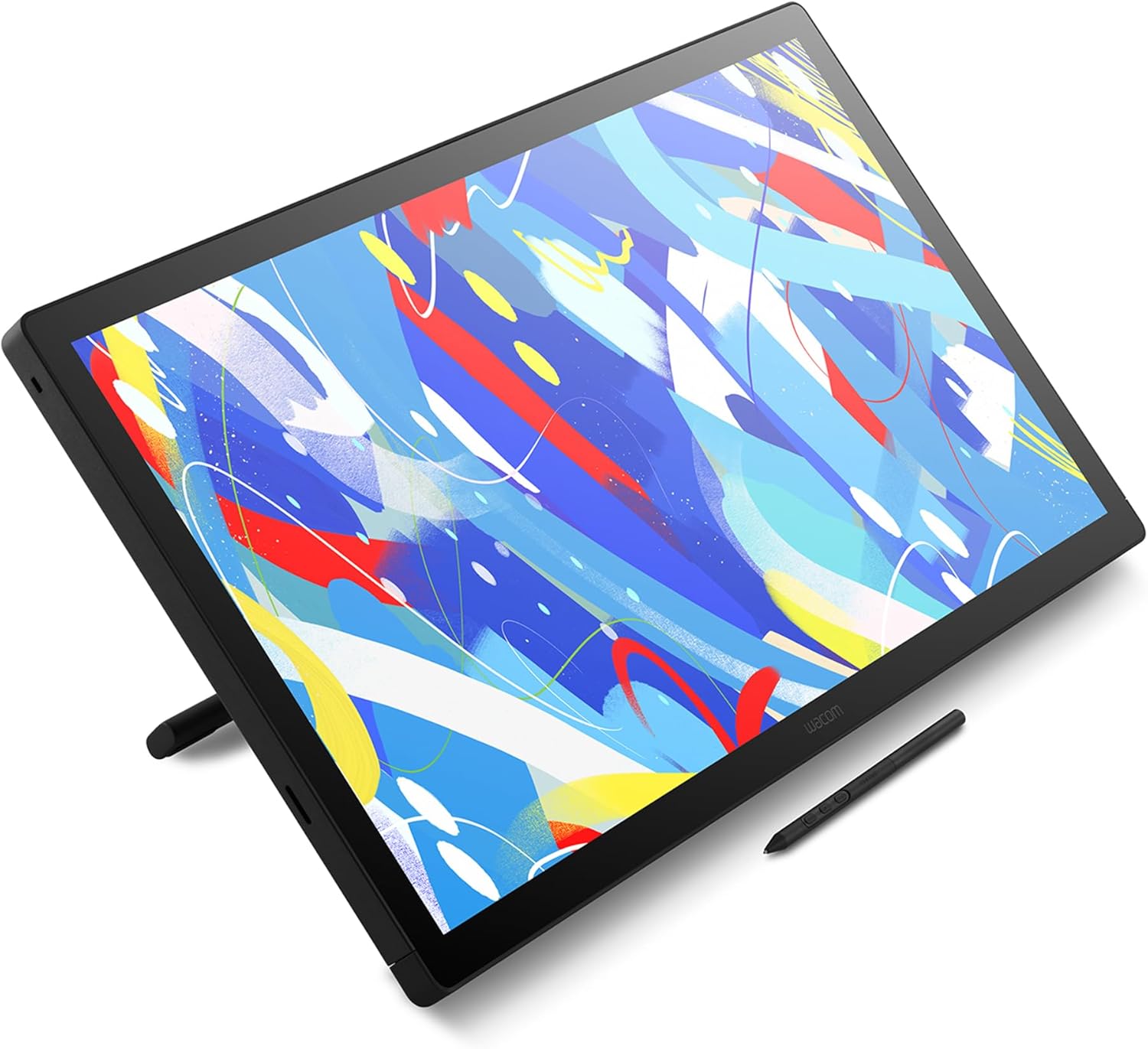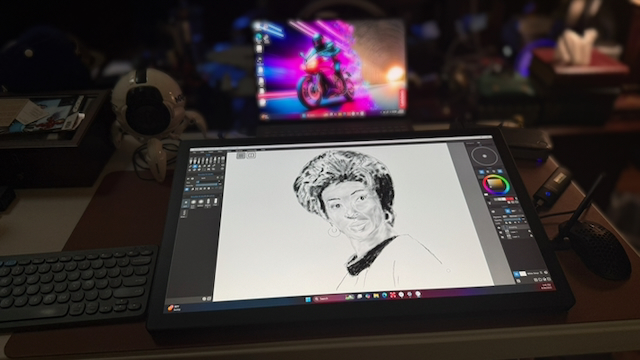
Wacom Cintiq 24 Touch Review

Summary
The Cintiq 24 Touch offers a premium 2.5K display, anti-glare bonded glass, ten-finger touch support, and responsive pen input. Its mass and dependence on extra hardware make it a serious tool—powerful, but requiring dedication.
Wacom Cintiq 24 Touch Review
The Wacom Cintiq 24 Touch is a lot of device. Not just in price or promise, but in sheer physical presence. It’s a relatively massive piece of equipment, and not the kind of thing that easily sneaks onto a crowded desktop where a keyboard, mouse, and laptop already wrestle for territory. This isn’t the kind of tool you casually tuck beside a monitor; it demands its own stage. Artists already accustomed to tilted drawing tables know what they’re getting into.

For me, the Wacom Cintiq 24 Touch arrived in my workspace like a visiting dignitary—impossible to ignore, insistent that I bring it a new surface (a foldable table) because, while I have a desk and a credenza, it wouldn’t fit among the existing equipment. The Cintiq demanded a dedicated space.
That said, once I gave it space, the Wacom Cintiq 24 Touch proved itself a remarkable screen. The quality of the display is excellent, but what really surprised me was the touchscreen. Using it brought to mind that moment in Independence Day where the alien interface was nothing but sweeping, cinematic touch gestures. Every time I tapped, swiped, or pinched, I found myself wishing that one day my entire desk might just be a millimeter-thin touch surface. Touch here feels natural in a way it doesn’t on a laptop, where the keyboard gets in the way–and it feels even more inviting than an Apple iPad Pro or a tablet PC because it is fixed to a space, and heavy enough that it asserts an immovable presence. The Cintiq pulls interaction forward into your space, daring you to make it the primary interface.
As a drawing device, it’s heavy, thick, and purposeful. Those are not bad adjectives if you draw all day. It’s meant to stay put, and in that stability, it delivers a serious digitizer experience. My setup put the Cintiq in front of my laptop, which meant awkwardly reaching over the Cintiq or reaching for a wireless keyboard that sat to the side, or on my lap (an interesting juxtaposition), whenever text was required. That friction underscores a simple truth: unless drawing is the main reason for bringing this, the Cintiq 24 into the office, it will feel like overkill. But when it comes to creating, the responsiveness is impressive, the pen pressure reliable, and the interface in programs like Rebelle 7 fluid enough to mimic the smudges, rubs, and strokes I still instinctively reach for from my days with pencil and charcoal.
I’ll admit, the pen itself left me wishing for more finesse. It’s utilitarian—straight, button-laden, and not particularly ergonomic. I prefer the intuitive gestures of flipping a pencil over to erase, or Apple’s double-tap trick for switching modes. Instead, I ended up using the pen in its simplest form and relying on the interface itself to make tool changes. Oddly enough, touch carried more of the workload for me than the pen, and I didn’t mind. The Cintiq’s touch input is that good.
So yes, the Cintiq 24 is a lot—big, heavy, and demanding of space like a large dog curled up on the end of a twin bed. But it also creates moments where interaction feels futuristic and art feels natural, even when I’m sketching with and blurring bits. It’s not a device for dabblers, and it isn’t meant to quietly coexist with other gear. It wants to be the centerpiece, the desk itself. And if you let it, it will likely become a powerful creative companion.
Wacom Cintiq 24 Touch: Key Specifications
| Specification Area | Cintiq Design |
|---|---|
| Connectivity Technology | USB-C cable to connect to Windows/Mac computers with DisplayPort Alt Mode or Thunderbolt 3 or 4 input (computers without DP Alt or TB 3 or 4 input require additional cables) |
| Pen Pressure Sensitivity | 8192 Levels |
| Operating System | Android 8.0 and above, Windows 10 or later, macOS 13 or later |
| Additional Features | 24″ IPS LCD, 60° Tilt Support, 8-bit color depth, Multi-Touch Screen, adjustable stand |
| Display Type | LCD |
| Compatible Devices | Android, Desktop, Laptop |
| Native Resolution | 2560×1440 |
| Weight | 11 lb without stand |
| Dimensions | 13.4 x 22.4 x 0.8 in |
What we like
Pros
- High-fidelity color and resolution
- Anti-glare bonded display minimizing parallax
- Ten-finger multi-touch support
- Stable, dense build with minimal flex
- Strong responsiveness, low lag
- High-end pen sensitivity (8192 levels, tilt)
- Single cable connectivity for many
The display of the Wacom Cintiq 24 Touch is its core strength. Its 2.5K IPS panel offers sharp detail across a large (23.8”) canvas, and the color fidelity via 100 % sRGB ensures that what is seen on screen has integrity. The anti-glare glass with a slight texture helps reduce reflections while preserving a pleasant drawing feel. Because the glass is bonded to the display with a negligible gap, parallax is effectively suppressed in ordinary use. The result is that strokes land where one expects, bringing a closeness to traditional media.
Touch support is unexpectedly delightful at this scale. The device’s ability to interpret ten-finger gestures—pinch-to-zoom, rotate, pan—makes it feel less like a static drawing surface and more like an interactive workspace. It changes how one navigates the canvas, and in some contexts the touch becomes more efficient than invoking UI controls via keyboard or mouse. This layer of interactivity is one of the features that elevates the design beyond “just a big pen display.”
Structurally, the Wacom Cintiq 24 Touch is built to stay grounded. The solid, dense construction resists flex, wobble, or minor knocks. In practice, it holds position reliably even when the pen is used near the edges, which is essential when one is pushing ink and shading hard. The sense of solidity avoids the “floating tablet” nervousness that can plague lighter screens. The Cintiq ships with a sturdy, low-slip base that lets the display tilt smoothly into drafting-table postures. It also supports VESA 75×75 if a monitor arm or alternative mount makes more sense for the workflow.
Responsiveness is strong. In my trials, the interface kept up with fast strokes, brush work, and even quick transitions between tools. I did not observe perceptible lag in normal sketching or painting tasks. Coupled with the pen’s 8192-level sensitivity and tilt support, the input fidelity offers nuanced brush control. Systems with modern graphics and driver support can drive the 2.5K display without bogging down, making the device feel like a companion rather than a burden.\

Pricing aligns with the intent. At $1,299.95 (pen only) and $1,499.95 (pen + touch), Cintiq 24 undercuts the Pro 24’s 4K and wider-gamut ambitions by a wide margin while delivering the core Wacom drawing experience. For teams standardizing on sRGB deliverables or for creators who color-grade on separate displays, the economics make sense.
Connectivity and setup are cleaner than in previous Wacom generations. The move to discrete HDMI and USB-C simplifies cabling. Those with Thunderbolt should be able to drive the display with just one cable.
While Wacom highlights its eco-initiatives, such as using FSC-certified paper for packaging and printed materials, and designing packaging to reduce waste and states a commitment to lowering environmental impact across product and packaging design, the Cintiq 24 Touch product description does not disclose details like recycled plastic content, carbon footprint, or lifecycle impact.

What could be improved
Cons
- Heavy and large—challenging to reposition
- Pen ergonomics and button layout feel utilitarian rather than inspired
- WQHD and 8-bit/100% sRGB fall short of 4K, wide-gamut needs.
- Some may see the Mini-HDMI + single USB-C as limits to connectivity flexibility
- No built-in ExpressKeys.
- Touch costs extra; no multi-touch on the base model.
- Not a color-critical reference display; 1000:1 contrast typical of IPS.
At over 11 pounds with the stand installed, the weight and size of the Wacom Cintiq 24 Touch are constants—and often an obstacle. Repositioning the unit is cumbersome, cables demand slack, and desk real estate must be generously cleared. It feels less like a tool one shifts while working and more like a semi-permanent installation. For mobile workflows, that becomes a constraint.
The pen, while technically capable, lacks in ergonomic subtlety. Its straight barrel, limited grip texture, and fixed layout of three buttons make long sessions more fatiguing than necessary. Users may inadvertently hit buttons while adjusting the grip. The absence of a flip-to-erase gesture or a more intuitive mode switch places the burden back on the interface or on manual selection, which can interrupt flow, or, depending on the artist, be a positive.
Creators working in broadcast, print proofing, or film pipelines may find WQHD and 100% sRGB color spaces limiting compared to 4K panels with Adobe RGB or DCI-P3 color targets. The Cintiq 24’s 8-bit color and 1000:1 contrast will not replace a calibrated reference monitor in color-critical environments. Those requirements remain the realm of the Pro line—or a dedicated grading display—so equipment planning should reflect that separation of concerns.
Port selection is serviceable rather than expansive. One Mini-HDMI and one USB-C keep desks tidy, but reduce flexibility for daisy-chaining or complex switcher setups. As a USB-C-first advocate, Wacom provides enough ports to support the most common connectivity types without complicating the hardware or driving up component costs for those few who still require legacy ports.
The absence of built-in ExpressKeys means that shortcuts rely on software overlays, the keyboard, or other devices. Studios that depend on hardware macro keys might factor an accessory into the total cost.
The gesture experience sits behind a bit of a paywall. Multi-touch is reserved for the $1,499.95 Touch model; the base configuration does not include it. For creators who have internalized pinch-zoom and rotate as part of muscle memory, that $200 delta becomes less an option than a necessity. The segmentation makes sense in the portfolio, but it does introduce a decision point for buyers.
Wacom Cintiq 24 Touch: The bottom line
The Wacom Cintiq 24 Touch modernizes Wacom’s mid-range pen display with brighter output, low-latency input, and simpler cabling, all wrapped in a chassis that sets up easily on a stand or arm. It doesn’t aim to be a colorist’s panel, and it doesn’t pretend to be. For drawing, layout, animation blocking, and iterative design in sRGB-oriented workflows, it delivers the core experience at a price that is significantly lower than the Pro tier. Those requiring 4K resolution or wide-gamut coverage should look upstream; everyone else will find it a capable and dependable drawing surface here.
With the Cintiq 24 Touch, Wacom offers an ambitious melding of high-quality display and multi-touch interactivity in a large-format drawing device. Its strengths lie in fidelity of color, touch-enabled navigation, and robust construction. But its compromises—weight, pen ergonomics, and control omissions remind us that striking a balance at this scale is difficult. For creators who commit to making the Wacom Cintiq 24 Touch a central fixture of the workspace, it can pay dividends. For those expecting it to flexibly coexist among peripherals, the friction may outweigh the promise.
Wacom provided the Wacom Cintiq 24 Touch for review. Images courtesy of Wacom unless otherwise noted.
Serious Insights is an Amazon Affiliate. Clicking on an Amazon link may result in a payment to Serious Insights.
For more serious insights on hardware and accessories, click here.
If you found value in this review of the Wacom Cintiq 24 Touch, please like it, leave a comment or share it with friends and colleagues. We appreciate you!

Leave a Reply